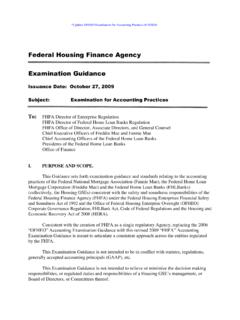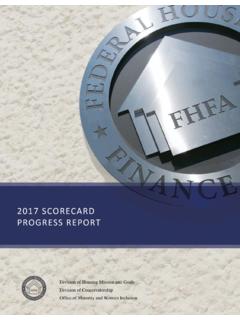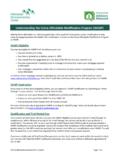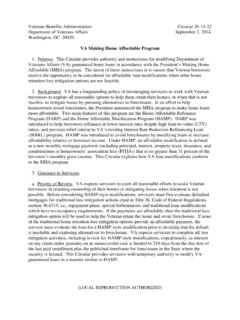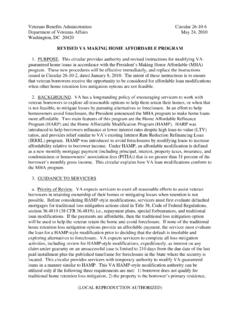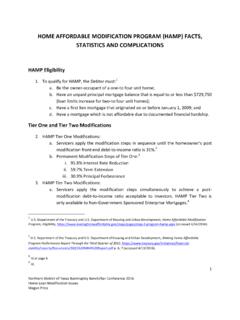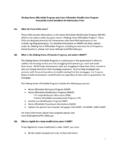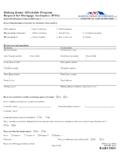Transcription of FHFA Working Paper 11-1: The HAMP NPV Model …
1 FHFA Working Papers Working Paper 11-1 The HAMP NPV Model : Development and Early Performance1 The foreclosure crisis that began in 2008 triggered the need for new approaches to treat distressed mortgages. A key component of the Obama Administration s home affordable modification Program (HAMP) was the development of a standardized Net Present Value (NPV) Model to identify troubled loans that were value-enhancing candidates for payment-reducing modifications. This Paper discusses the development of the HAMP NPV Model , its purpose, and some important constraints that dictated its structure and limitations. We describe the structure and the estimation of the Model in detail. Furthermore, we describe the responsiveness of the Model to key characteristics, such as loan to value and credit score and provide new evidence on the relationship between HAMP modification performance and key borrower and modification characteristics.
2 The Paper concludes with a discussion of Model limitations and suggestions for further refinement of the Model . Steve Holden Therese Scharlemann Fannie Mae Department of the Treasury Austin Kelly Ryan Singer Federal Housing Finance Agency Federal Deposit Insurance Corporation Douglas McManus John D. Worth Freddie Mac National Credit Union Administration Authors Note: The home affordable modification Program (HAMP) is arguably the federal government s most important intervention into housing markets to encourage loan modifications for distressed homeowners. The creation and rollout of the Net Present Value (NPV) Model was a critical innovation in HAMP and has played an important role in the program. James Berkovec played an important role in developing the first version of the NPV, directing the development of the default Model and offering substantial leadership and guidance throughout the process.
3 1 We would like to thank Richard Green, Jenney Shen, Binzi Shu and two anonymous referees for helpful comments. Patty Koscinski and Sameem Siddiqui provided excellent research assistance. The authors also thank participants in the WEAI conference for comments. The views expressed in this Paper do not necessarily reflect the views of Fannie Mae, Freddie Mac, FHFA, Dept. of the Treasury, FDIC or NCUA. The first decade of the 21st century was as tumultuous for the housing sector as any in recent history. A sharp increase in housing-market activity, marked by a dramatic acceleration in home prices and new mortgage originations, was followed by a bust, during which delinquencies soared and housing prices plummeted. The housing bust was marked by a nearly unprecedented increase in mortgage delinquencies and foreclosures; in the first quarter of 2010 the Mortgage Bankers Association's national delinquency survey experienced the highest ever rates of delinquency in the series history.
4 The spike in defaults and decline in home values resulting in the collapse of non-prime MBS values was one of the chief proximate causes of the financial crisis. The federal government took a number of extraordinary actions to address the crisis, including a series of efforts aimed at foreclosure avoidance. The largest of these efforts was the home affordable modification Program (HAMP), launched in early 2009 using funding from the Troubled Asset Relief Program (TARP). As of the first quarter of 2011, HAMP had initiated over million trial modifications and made permanent over 670,000 modifications. Over one hundred servicers accounting for about 80 percent of outstanding residential mortgage debt being serviced signed up to participate in HAMP. HAMP was designed to facilitate bulk processing of loan modifications by requiring and subsidizing a specific streamlined modification structure, which could be evaluated by a single, batch-process decision-making framework.
5 Most pooling and servicing agreements require servicers to increase the value of cash flows to investors. In the context of modifications this can be interpreted as a requirement for present value improving modifications. HAMP was therefore designed to provide both a decision-making framework to neutrally assess the value of a specific modification structure and subsidies for mortgage investors to increase the value of modified loans. HAMP emphasized bulk processing and a streamlined modification structure because at the beginning of the foreclosure crisis large mortgage servicers were unprepared for the overwhelming volumes of seriously delinquent loans and had minimal infrastructure for evaluating these loans for loss mitigation. The design of HAMP also reflects the understanding that in many cases loan modifications that would be value-improving for investors relative to foreclosure were not being identified and executed as a result of obstacles within the existing market In HAMP, value-enhancing modifications are identified using the Net Present Value (NPV) Model .
6 The NPV Model compares the expected discounted cash flows associated with the modification of a loan considering probabilities of default under two scenarios: the loan is modified according to HAMP terms and the loan is not modified (hereafter referred to as mod and no-mod ). A loan that is NPV positive where the value of the probability-weighted mod cash flows exceed the value of the probability-weighted no-mod cash flows is considered to be a good candidate for modification . Testing modifications for positive NPV generally eliminates borrowers who are very unlikely to be foreclosed upon or who have substantial positive equity, because in both cases the mortgagee or lien-holder is unlikely to suffer meaningful losses in the no-mod case. The NPV test also eliminates borrowers for whom a modification does not meaningfully reduce their prospects of foreclosure.
7 In these cases the costs of the modification in terms of reduced cash flows are not balanced by a reduced probability of foreclosure. This Paper provides a review of the development, mechanics, and operation of the HAMP NPV Model , introduces initial measures of the performance of the Model , and offers a view of future challenges to the evaluation of modifications3. The Paper is organized as follows. Section I discusses the HAMP program design. Section II describes the development of the NPV Model , Section III discusses the workings of the NPV Model , Section IV provides simulation and empirical results that provide insight into the Model outcomes. Section V discusses limitations of the Model , describes future challenges and opportunities, and concludes. I. HAMP Program Design 2 See Cordell et al.
8 (2008) for a discussion of institutional barriers to loan modification and Foote et al. (2009) and Adelino et al. (2009) discuss economic barriers to loan modification . 3 The authors represent the Working group tasked with development and enhancement of the NPV evaluation tool. The tool was designed to implement the administration s HAMP policy. A discussion of the policy choices that influenced the design of the NPV Model is beyond the scope of this Paper . HAMP facilitates rapid, objective evaluation of loan modifications by providing a batch decision-making tool (the NPV Model ) and a standardized modification structure. The program provides subsidies for servicers to conduct modifications, potentially ameliorating a recognized misalignment in financial incentives in servicing contracts (see Cordell et al. (2008)). The program also increases the value of modifications to investors with the addition of subsidies to mortgage investors.
9 The program includes outreach and solicitation requirements to ensure fair and consistent treatment of all borrowers and helps to establish industry best practices in an area where few rules existed. Participating servicers must solicit all borrowers who become 60 or more days delinquent for a HAMP modification , and they are required to evaluate every eligible loan using the standardized modification terms and the standardized net present value (NPV) The servicer is required to offer the homeowner a modification in cases where the proposed modification is NPV a. The HAMP modification The HAMP modification is structured to achieve a first-lien mortgage-debt-service to income (hereafter front-end DTI ) target of 31 percent. For an otherwise eligible modification to qualify for HAMP subsidies, the borrower s monthly payments of principal and interest on their first lien, taxes, insurance, and homeowner association (HOA) fees must not exceed 31 percent of their gross monthly income.
10 The standard HAMP modification achieves the 31 percent DTI target through a uniform sequence of three steps (hereafter referred to as the modification waterfall ). The waterfall consists of: (1) a rate reduction to as low as 2 percent; (2) if necessary, a term extension up to 40 years; and (3) as necessary, principal forbearance. The rate reduction remains in place for the first 5 years of the program. Following the fifth year, the borrower s interest rate rises by one percentage point each year until it reaches the Freddie Mac Primary Mortgage Market Survey (PMMS) rate for 30-year fixed-rate mortgages that was in effect at 4 In addition, the HAMP program can modify borrowers who servicers determine to be at risk of imminent risk of default even if they are current or only 30-day delinquent on their mortgage.


